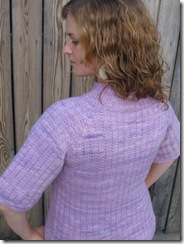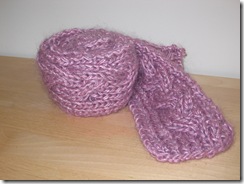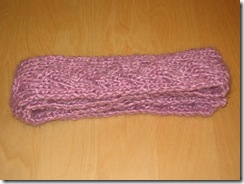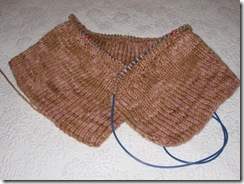Viscose, or rayon, was first developed in 1855, by George Audemars. Commercial production didn’t begin until 1891, and wasn’t practicable until 1894, when Charles Frederick Cross, Edward John Bevan, and Clayton Beadle determined that treating plant fibers (cellulose) with carbon disulphide created a viscous liquid (they called viscose) that could be spun into filaments and then woven into fabric or spun into yarn; it was the spun textile that was called rayon. In Europe, the terms “viscose” and “rayon” are used interchangeably to refer to the yarn/textile.
In brief, the process begins with plant fibers—wood pulp, bamboo, or the like. In the case of wood, the pulp is boiled and treated with chemicals, then kneaded into “crumbs.” These crumbs are churned with carbon disuplhide, which is how they turn into the viscous liquid called viscose. This liquid can then be stun into staple fibers. Here’s a visual overview of the process, courtesy of
ExplorePAHistory.com.
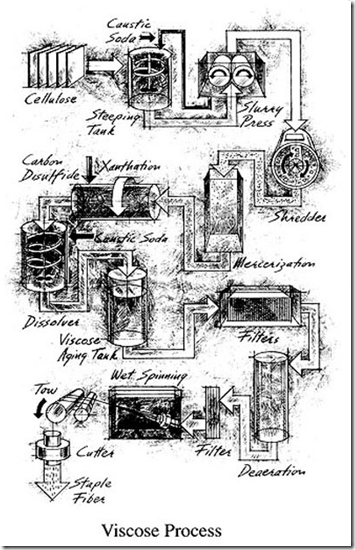
Here’s an image of viscose staple fiber:
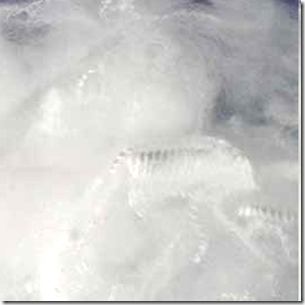
The staple fiber can then be woven into fabric or yarn. For more on the process of rayon production, check out
this great website.
Rayon became popular as a textile in the 1920s:
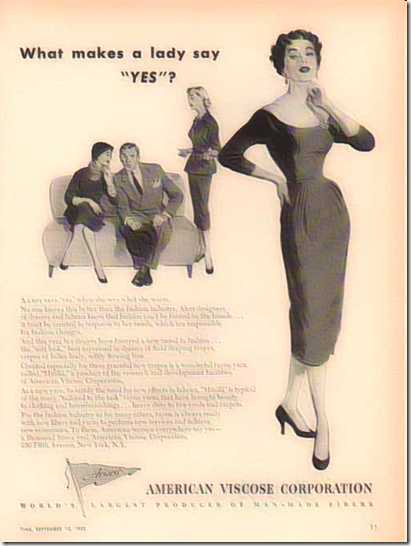
(Courtesy of
ExplorePAhistory.com)
As environmental concerns become increasingly important for knitters, we are likely to see even more yarns made from plant fibers—bamboo, wood pulp, corn, hemp, and the like. Cellulose-based fibers familiar to knitters include bamboo, viscose, rayon, and the trade names Tencel and Modal. While they tend to stretch out more than some other fibers, their advantages are many. Cellulose fibers tend to be lustrous, smooth, cool and comfortable, making them ideal for summer and spring-weight sweaters. But are these fibers really as environmentally friendly as we think?
On the one hand, plant fibers are renewable resources. The fibers used for yarns tend to grow quickly.
Yet, the production process for rayon and other plant fiber still entails some environmental damage. Most rayon factories treat cellulose with chemicals including sulhpuric acid, carbone disulphide, chlorine, and/or caustic soda. The carbon disulphide used in the process released into the environment as a gas. (1) According to the
Government of Australia, the effects of high exposure to carbon disulphide include:
Acute effects: At very high levels, carbon disulfide may be life-threatening because of its effects on the nervous system or heart. Exposure can be through inhalation, absorption through the skin, ingestion, or skin or eye contact. In acute poisoning, early excitation of the central nervous system resembling alcoholic intoxication occurs, followed by depression, stupor, restlessness, unconsciousness, and possible death. If recovery occurs, narcosis, nausea, vomiting, and headache can occur.
Chronic effects: In chronic poisoning, there are sensory changes such as a crawling sensation in the skin, sensations of heaviness and coldness, and "veiling" of objects so that they appear indistinct. Exposure can cause changes in breathing, chest pains, muscle pain, weakness, loss of feeling in the hands or feet, eye problems, skin blisters, chronic fatigue, loss of memory, personality changes, irritability, dizziness, anorexia, weight loss, psychosis, polyneuropathy, gastritis, kidney and liver damage, dermatitis, mental deterioration, Parkinsonian paralysis, and insanity.
Ouch. While we probably don’t need to worry about our own exposure when knitting with this yarn, we should consider whether workers are exposed to unsafe levels of this chemical.
We might also worry about environmental effects:
Acute (short-term) ecological effects: Acute toxic effects may include the death of animals, birds, or fish, and death or low growth rate in plants. Acute effects are seen two to four days after animals or plants are exposed to a toxic chemical substance. Carbon disulfide has moderate acute toxicity to aquatic life. No data are available on the short-term effects of carbon disulfide to plants, birds, or land animals.
Chronic (long-term) ecological effects: Chronic toxic effects may include shortened lifespan, reproductive problems, lower fertility, and changes in appearance or behaviour. Chronic effects can be seen long after first exposure(s) to a toxic chemical. Carbon disulfide has high chronic toxicity to aquatic life. No data are available on the long-term effects of carbon disulfide to plants, birds, or land animals.
Fortunately, producers are developing organic solvents that may cause less environmental damage (1).
Seriously, who knew our yarn habits could have such serious environmental effects?
1. Environment friendly process for rayon. By: Narayan, Kudlip, Chemical Business, 09703136, Sep97, Vol. 11, Issue 2















